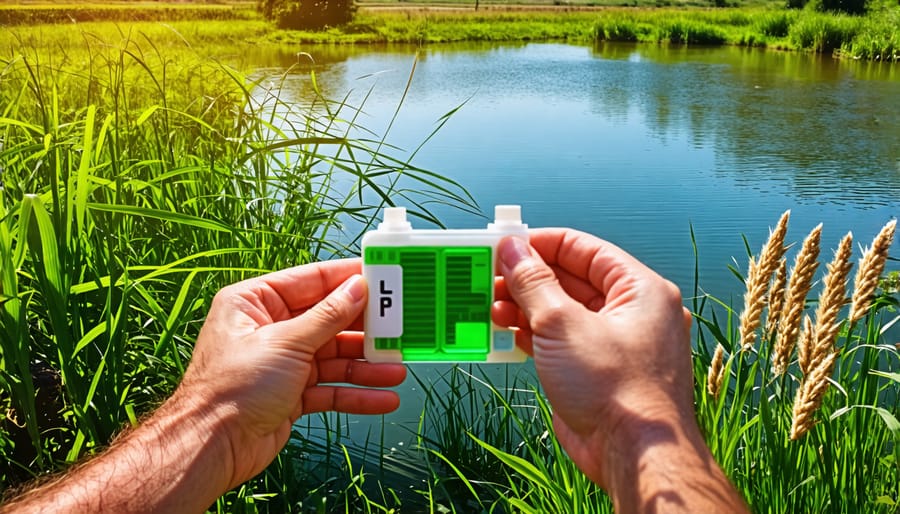
Why Every Water Gardener Should Test Their Farm Pond Water (And How to Do It!)
Test your farm pond water regularly to ensure it supports a thriving ecosystem. Begin by collecting a water sample in a clean container, ideally during a cool part of the day, to avoid heat interference. Analyze the pH level using a simple test kit, aiming for a range between 6.5 and 8. For nutrient levels, check for nitrogen and phosphorus to prevent algae blooms; too much can harm fish and plants. Additionally, measure dissolved oxygen—crucial for fish health—using a digital meter to ensure levels stay above 5 mg/L. Each step is crucial for maintaining the beauty and health of your pond, allowing you to act swiftly if any parameter falls out of acceptable range. Prioritize testing especially after heavy rainfalls or nearby agricultural activity, as these can significantly alter water quality. Finally, keep a log of your water tests to track changes over time, forming a proactive approach to pond management.
Understanding the Importance of Pond Water Testing

Health and Safety of Aquatic Life
Testing the water in your farm pond is like giving a wellness check-up to your favorite aquatic friends. It helps ensure a healthy environment where fish and plants can thrive. Think of the water as the lifeblood of your pond; maintaining its quality is crucial. By regularly testing, you can monitor vital parameters like pH, ammonia, nitrate, and dissolved oxygen levels. These are essential to keep your fish happy and your plants lush.
Imagine discovering early signs of stress in your fish or that certain plants are not growing as they should. Water testing allows you to identify and address these issues before they become serious. Say, for instance, your pond’s pH level becomes too high—it can stress the fish, making them more susceptible to illness. By regularly performing these tests, you’re providing your aquatic life with the best care possible, ensuring they flourish under your watchful eye, making every visit to your pond a delightful experience.
Preventing Algae Blooms and Other Issues
Testing your farm pond water regularly is a friendly, enthusiastic way to maintain its health and beauty. Algae blooms, for instance, can quickly turn your serene water feature into murky trouble. By checking key parameters like nutrient levels, you can stop these blooms before they start. High phosphorus and nitrogen levels often invite algae, so testing helps spot these hidden imbalances. This not only aids pond water clarity, but also keeps fish and plants happy. Imagine waking up to a pond that truly reflects the sky—quite a rewarding view for any homeowner! Consider using a simple testing kit, a practical tool for your pond’s well-being. Just like a seasoned gardener tends to soil health, you’re nurturing your pond by preventing issues before they arise. And remember, every test you perform adds a little peace of mind, ensuring your watery haven stays inviting and vibrant.
What Parameters to Test in Your Farm Pond

pH Levels
pH levels in your farm pond can make a big difference between a thriving aquatic environment and one that’s struggling. Measuring pH is simple, and it’s a crucial step in pond maintenance, as it helps ensure a balanced ecosystem for fish and plants. The ideal pH range is typically between 6.5 and 9.0, allowing biological processes to function efficiently. Too high or too low, and it may spell trouble with fish health or plant growth. Testing kits are readily available and easy to use: just collect a water sample, follow the instructions, and compare the results. Regular checks can help spot issues early, ensuring the pond remains a picture-perfect piece of nature in your backyard.
Ammonia and Nitrite Levels
Monitoring ammonia and nitrite levels in your farm pond is crucial for keeping your fish happy and healthy. These substances, produced from fish waste and uneaten food, can build up quickly, turning your serene pond into a toxic environment. High ammonia levels can stress fish, damage their gills, and even lead to death. Nitrites, which are converted from ammonia by beneficial bacteria, are equally harmful, often causing oxygen deprivation in fish. Regular testing helps you spot these harmful substances early, allowing you to take action like improving filtration or changing water. Create a thriving pond where fish can flourish by making ammonia and nitrite testing part of your regular maintenance routine.
Dissolved Oxygen
Dissolved oxygen (DO) is a key player in maintaining a vibrant and healthy pond ecosystem. It acts like a breath of fresh air for your pond, supporting fish health, breaking down organic matter, and preventing unwanted algae blooms. When oxygen levels drop, you’ll notice sluggish fish, murky waters, and a rise in smelly gases. To keep these issues at bay, regular testing is essential.
Testing DO is like checking your pond’s pulse, ensuring all the life within it thrives. A quick test every now and then provides the information you need to adjust aeration setups, whether it’s a fountain, waterfall, or an air pump. I remember when I first tested my pond and realized the subtle ripple of my fountain wasn’t enough. A small pump transformed it, bringing life back to my Koi and clarity to the water.
With the right balance, you’ll see your pond flourish, full of lively fish and crystal-clear waters. Regular DO testing helps you anticipate issues before they become big problems, keeping your DIY pond looking and feeling its best year-round.
How to Test Your Farm Pond Water

Choosing the Right Testing Kit
Choosing the right testing kit for your farm pond is like picking tools for your garden—selecting the right one makes all the difference. Start by considering the key water quality parameters you need to measure. For most DIY enthusiasts and pond lovers, a basic kit that tests for pH, ammonia, nitrites, and nitrates will cover the essentials. If you have fish or plants that are particularly sensitive to water changes, look for kits that offer tests for oxygen levels and phosphate.
Ease of use is also important, especially if you’re just starting out. Opt for kits that come with clear instructions and color-coded charts, making the testing process straightforward. Digital testers, although slightly pricier, offer more precise readings and are perfect for those who want to delve deeper into the science of their pond environment. Finally, reflect on any personal anecdotes from your water gardening adventures—has your pond struggled with algae? Or perhaps your fish haven’t been thriving? Tailoring your testing kit choices to your specific needs ensures a beautifully balanced pond.
Conducting the Tests: A Step-by-Step Process
Testing your farm pond water is a crucial step to maintaining a healthy environment for plants and wildlife. Here’s a simple, step-by-step guide to help you navigate the process with ease. If you’re just embarking on a DIY pond setup, these steps will also be invaluable.
Begin by gathering the necessary supplies: a reliable water testing kit and water sampling containers. Kits often include tests for pH, ammonia, nitrites, nitrates, and phosphates—key parameters for a balanced pond ecosystem.
Step one, take water samples from different areas of your pond. Consider areas that receive a lot of sunlight or shade and spots near inflows or outflows. This variety offers a more comprehensive view of your pond’s overall health.
Next, follow the instructions provided with your water testing kit carefully. Each test may require different procedures, such as dipping test strips or using drops. Ensure the readings are accurate by double-checking each result.
After the tests are complete, compare your results with recommended levels. For example, ideal pH levels typically range from 6.5 to 8.5. High ammonia or nitrite levels can be harmful to aquatic life and might indicate an issue with your biological filtration system.
Finally, record the results and any necessary actions you take. Tracking changes over time can help you identify patterns and prevent potential problems before they escalate.
Remember, regular water testing is an essential part of pond maintenance. With these steps, you can enjoy a thriving pond all year round!
Interpreting Test Results and Taking Action
Understanding your pond’s test results is akin to reading a health report, where each parameter tells a story about your water body’s condition. First, check the pH levels. Ideally, your pond should maintain a pH between 6.5 and 8.5. If your results are outside this range, don’t worry. Adjustments can be made using pH increasers or reducers available at most garden centers. Another critical parameter is ammonia. High ammonia levels can harm your fish, so if detected, consider increasing water changes or improving filtration.
Next, pay attention to nitrate and nitrite levels. An optimal nitrate level is below 50 ppm, while nitrite should remain close to zero. If these numbers creep higher, enhancing your pond’s biological filtration through more beneficial bacteria or aquatic plants can help rebalance. Phosphates sneaking over 0.05 ppm can lead to algae blooms; if detected, consider reducing fish feeding or adding phosphate removers.
Always remember, testing your pond is just the beginning. It’s an ongoing journey of discovery and action. And if you’re curious about more detailed testing processes, dive into techniques tailored for a healthier pond habitat by exploring koi pond testing strategies. Embrace this insightful practice to ensure your pond continues to thrive vibrantly.
Conclusion
In conclusion, regular water testing is vital for maintaining a thriving farm pond, ensuring it remains a healthy and beautiful ecosystem. By monitoring key parameters, pond lovers can identify potential issues early, preventing costly damage and supporting the well-being of aquatic life. Whether you’re a seasoned water gardener or just starting your journey, establishing a routine for checking water quality will give you peace of mind and enhance your pond’s natural allure. So, roll up those sleeves and dive into the rewarding practice of caring for your pond, nurturing both your passion and the environment.
